
Currently it seems to end at the sea shoreline of Portland Bay but in fact the flow continued, during a period of low sea level, into the current Bay area for a further 15 km.
The molten basalt of the Tyrendarra lava flow from Budj Bim (Mt Eccles) came from an eruption 36,900 +/- 3,100 years ago (ya). This was not its only eruption and the last occurred some 6,500 ya. Today Lake Surprise fills the craters of the now extinct volcano.

It is thought that the Lake Condah was formed by a wall of basalt that blocked off the natural drainage. Peat from the base of Lake Condah swamp has been dated at just over 6,000 (ya) a which gives an indication of when the lake may have formed.
The World Heritage site, Budj Bim Cultural Landscape is divided into three components all based on rock from the initial Tyrendarra flow. Lake Condah, Darlot Creek, Budj Bim (Mt. Eccles) and the broad section of the Tyrendarra lava flow are contained in the northern component. The central component of this divided Cultural Landscape, Kurtonitj, also on the flow which is bordered on each side by the Fitzroy River on its west and Darlot Creek on the east. The southern component, named Tyrendarra, also has a north-south orientation. It is east of Tyrendarra township and contains the basalt and the wetlands between the river and the creek.
In response to the autumn and winter rains the basalt surface has produced a landscape with swamps, wetlands and low-lying land prone to flooding on each of the three Cultural Landscape components. These provide an ideal habitat for Kooyang, the short-finned eel, a fish that featured prominently in the lives of the Gunditjmara people for some 6 000 years.
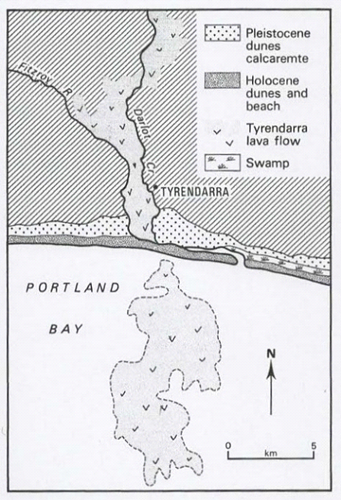
The southern section of the Tyrendarra lava flow
on land and under Portland Bay
(adapted from E.C. Bird, The Coast of Victoria. MUP, 1993)
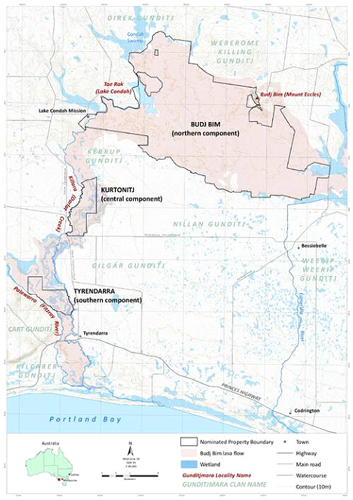
Location map showing Lake Condah, sections of
Budj Bim World Heritage site in southwestern Victoria
with their relationship to Darlot Creek and in the south-west to the Fitzroy River.
(adapted from the UNESCO via Creative Commons Licenses)
Elvers (juvenile eels) from the Southern Ocean move up the local streams like Darlot Creek then spread out to the wetlands where they mature into adult eels. The elvers may cross moist land surfaces to reach their destination where they live until they reach sexual maturity. Between the age of 15 and 30 years when the females reach maturity they are about a metre long; males are slower growing and smaller reaching maturity when 14 years old. At this stage these adults return to the salt water and migrate from the Southern Ocean to tropical locations like the Coral Sea off New Caledonia to mate and produce the next generation.
It is mainly at this mature size that the Gunditijmara would have caught the animals in an elaborate system built using waterways they have dug and barriers they have built from basalt stones as part of their cultural landscape.
The barriers were fitted with platted tubular, tapered pot/trap and most trapping was during autumn as the adult eels begin their migration. The eels were caught as they emerged from the end of the pot, killed with a bite to the back of their head then used as fresh food or smoked as a means of preservation. Smoking was carried out by hanging the eels over smoky fires in the hollows of large eucalypt trees.
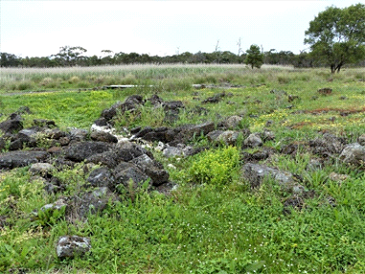
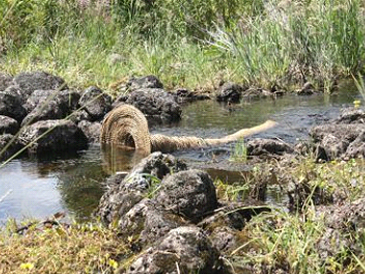
The earthworks and built channels connected swamps allowing water movement in both directions. In similar ‘engineering’ at nearby Toolondo, channels up to 2.5 km were constructed to also join swamps and archaeologist Harry Lourandos calculated that 13,000 hours of labour would have been involved in the project. While several of the local engineering works may have begun in the order of 6,000 ya, it is suggested that the system at Lake Condah may be more recent than this.
Other Gunditjmara built structures in this region were the many horse-shoe shaped dry stone walls shelters using the basalt boulders. These foundations had relatively shallow walls and most were 2-3 m in diameter though some, at 4 m-5 m, would have been capable of housing eleven people.
Archaeologist Josephine Flood suggests these shelters provided temporary housing and were roofed with sticks and sheets of bark but that describing the aggregation of these structures as ‘villages of stone houses’, as suggested by some authors, is an exaggeration [see The Original Australians. A&U, 2006]. The shelters served a purpose when the eels were being harvested but the clan groups and families moved to other sections of their country in outside the eeling season.
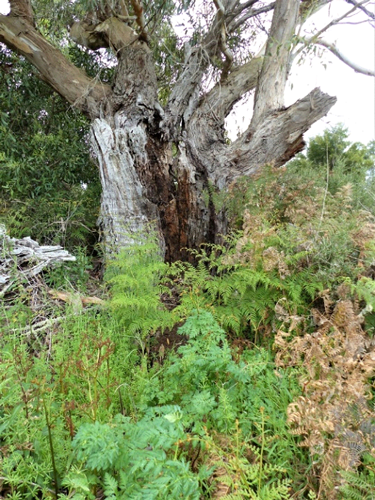
Remains of an aged eucalypt with the hollowed-out trumk that
had been used for smoking eels. Tyrendarra

Replica house built on one of the many shelter foundations found in Budj Bim
As a World heritage Area it is the most recently declared World Heritage site being Australia’s 20th and officially recognised by the UNESCO committee on 6th July 2019. The decision was based on the following main criterion that make it the only Australian World Heritage sites to be based only on cultural heritage.
Criterion (iii)
Gunditjmara knowledge and practices have endured and continue to be passed down through their Elders and are recognisable across the wetlands of the Budj Bim Cultural Landscape in the form of ancient and elaborate systems of stone-walled kooyang [eel] husbandry (or aquaculture) facilities.
Criterion (v)
The continuing cultural landscape of the Budj Bim Cultural Landscape is an outstanding representative example of human interaction with the environment and testimony to the lives of the Gunditjmara.

